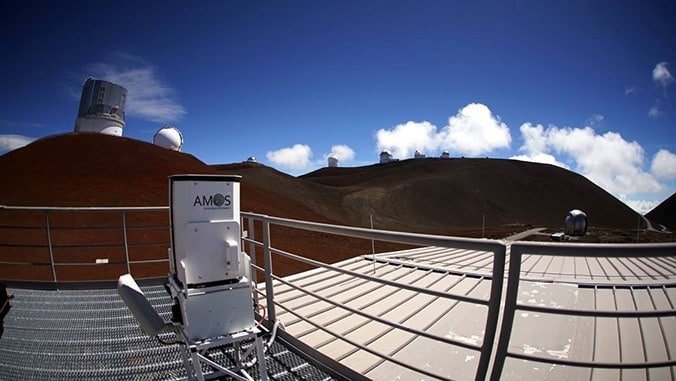Astronomers now have a new pair of eyes to detect meteors over Hawaiʻi using a state-of-the-art monitoring system installed on the rooftops of existing buildings on Maunakea and Haleakalā. The high-speed video devices are part of an expanding network of identical cameras in the Automated Meteor Observation System (AMOS).
The detectors are programmed to capture non-threatening meteors made up of tiny particles, no bigger than a grain of sand, burning up in Earth’s atmosphere. Those meteors are often recognized as, “shooting stars,” but they are actually miniature bits of space debris, which are relics of the early solar system, shining as they burn up in the atmosphere 60 miles above someone standing on Earth at 15 times the muzzle speed of high-powered rifles.
According to astronomers, the tiny meteors hold clues to the formation and continuing development of the solar system. Technically, they are called “meteors,” and are so numerous that they increase the mass of the Earth by about 20,000 tons per year.
“The opportunity to install AMOS systems on Maunakea and Haleakalā, two of the finest astronomical sites in the world, will provide us data to track meteors across the sky and determine their composition,” explained Peter Veres, an AMOS co-investigator at the Center for Astrophysics at Harvard University, and formerly at the University of Hawaiʻi Institute for Astronomy (IfA).
Capturing the ‘shooting stars’ path

AMOS uses fish-eye lenses to continuously take a video of the entire sky all night long. The advantage of having systems on both mountaintops is that meteors imaged by two cameras can be divided to determine their true path through the sky. The high-speed video images allow the researchers to determine a meteor’s speed at each point along its trajectory, so they can compute the deceleration of the debris due to air friction. After accounting for the atmosphere’s effect on the meteor they can project the particle’s path backwards in time to determine the meteoroid’s original orbit around the Sun, before it encountered Earth.
About half of all meteors come from “showers” of dust ejected long ago by an asteroid or comet, and planetary scientists sometimes know exactly which comet or asteroid is associated with a particular shower.
The AMOS system on Maunakea acquires a range of the brightest meteors during their fiery death plunge, that are then used to determine the types of atoms that the meteors contained.
“Combining the information about what a meteor is linked to allows us to determine the makeup of many comets and asteroids without the cost of sending spacecraft to each one,” said Robert Jedicke, a faculty member at IfA, and a collaborator on the AMOS project. The long-term goal of the project is to determine how the elements are distributed throughout our solar system. The detailed information provided from the meteors can be combined with information from ground- and space-based telescopes and spacecraft missions to build a comprehensive picture of how the solar system formed and continues to evolve.
Recovering chunks of meteors that land over Hawaiʻi
The AMOS cameras can accurately track the trajectory of a meteor when it is bright, and other techniques can be used to predict the path of any surviving chunks through the atmosphere all the way to the ground. Scientists can then recover these “meteorites” and perform detailed studies of their mineralogy in laboratories like the W. M. Keck Cosmochemistry Laboratory at UH’s Hawaiʻi Institute of Geophysics and Planetology. Most of the meteors above Hawaiʻi’s skies fall into the ocean, but a few will land on one of the islands.
The newly-installed meteor detectors are designed and built by Slovakian researchers from Comenius University in Bratislava, Slovakia. Juraj Tóth, the Principal Investigator in Bratislava said that “we are excited to be receiving excellent data from our two systems in Hawaiʻi, that have allowed this project to be the first global ground-based meteor observation system.”
The AMOS camera on Maunakea is hosted by the Submillimeter Array with approval of the Department of Land and Natural Resources. The SMA is operated under an agreement with the University of Hawaiʻi. The SMA is a joint project between the Smithsonian Astrophysical Observatory and the Academia Sinica Institute of Astronomy and Astrophysics and is funded by the Smithsonian Institution and the Academia Sinica (Taiwan). The Smithsonian Institution, founded in 1846 “for the increase and diffusion of knowledge,” is the world’s largest museum, education, and research complex. The Smithsonian Astrophysical Observatory, founded in 1890, and the Harvard College Observatory, founded in 1839, together form the Center for Astrophysics | Harvard & Smithsonian.


